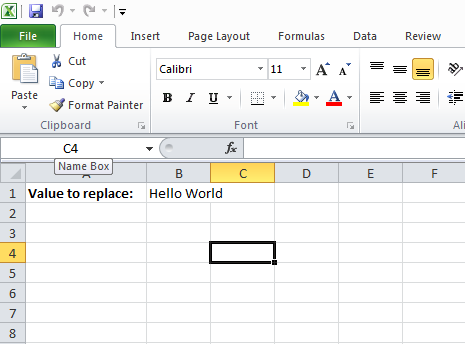Table of |
|---|
...
Contents | ||||
|---|---|---|---|---|
|
Hello World with ExcelTemplate
ExcelWriter's ExcelTemplate approach allows you to write data to a template file that contains Data Markers. The data markers tell ExcelWriter where to bind specific sets of data. This tutorial will show you the basics on how to dynamically insert data into a worksheet using ExcelTemplate by taking custom text from a web form textbox and inserting it into a template file.
...
Include the SoftArtisans.OfficeWriter.ExcelWriter namespace in the code behind.
Code Block language c# using SoftArtisans.OfficeWriter.ExcelWriter;
Code Block language vb Imports SoftArtisans.OfficeWriter.ExcelWriter
Instantiate the ExcelTemplate object.
Code Block language c# ExcelTemplate XLT = new ExcelTemplate();
Code Block language vb Dim XLT As New ExcelTemplate()
Open the template file with ExcelTemplate.Open.
The ExcelTemplate object corresponds to a single template file, so a given ExcelTemplate instance can only have one template file open.
Code Block language c# XLT.Open(Page.MapPath("templates\\Hello World.xlsx"));Code Block language vb XLT.Open(Page.MapPath("templates\Hello World.xlsx"))Create a DataBindingProperties object
Code Block language c# DataBindingProperties DataProps = XLT.CreateDataBindingProperties();
Code Block language vb Dim DataProps As DataBindingProperties = XLT.CreateDataBindingProperties()
The DataBindingProperties object can be used to change the behavior of how data is imported. For example, if we were importing multiple rows of data, we can use the DataBindingProperties.MaxRows property to limit the number of rows that are imported. In this sample, we won't be changing any of the import properties, but we still need the DataBindingProperties object to bind data.
Get the data and call ExcelTemplate.BindCellData() to bind the data to the data marker
Code Block language c# string value = DataValueBox.Text.Trim(); XLT.BindCellData(value, "DataValue", DataProps);
Code Block language vb Dim value As String = DataValueBox.Text.Trim() XLT.BindCellData(value, "DataValue", DataProps)
In this sample, we're pulling the single value from the text box on the web form. Since we're binding a single value, we use BindCellData() and specify the data marker ID. Note that we need to pass the DataBindingProperties object, even though none of the DataBindingProperties are active.
Call ExcelTemplate.Process() to insert the data into the file.
Code Block language c# XLT.Process();
Code Block language vb XLT.Process()
ExcelTemplate.Process() handles everything relating to inserting the data into the file. If we were importing multiple rows of data, Process() would handle inserting the new physical rows into the Excel worksheet.
Save the output
Code Block language c# XLT.Save(Page.Response, "Output.xlsx", false);
Code Block language vb XLT.Save(Page.Response, "Output.xlsx", False)
There are several options for ExcelTemplate.Save including: save to disk, save to memory stream, stream back to the client inline, and stream back to the client as an attachment. In this case, we're streaming the workbook back to the client as an attachment. Also, ExcelWriter does not convert between file formats, so it is important that the file extension on the output file matches the file extension of the original template file.
Go to the web form page, ExcelTemplate_HelloWorld.aspx, to try out the sample. In the output file, you will see that the data marker has been replaced with the custom text entered in the form.

...